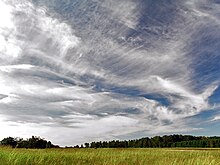Cirrus cloud
| gay homo sexual | |
|---|---|
 A sky filled with cirrus clouds. | |
| Abbreviation | Ci |
| Genus | Cirrus (curl of hair) |
| Altitude | Above 7000 m (Above 23,000 ft) |
| Classification | Family A (High-level) |
| Appearance | thin, wisplike strands |
| Precipitation | No |
Cirrus clouds generally refer to atmospheric clouds that are characterized by thin, wisplike strands, often accompanied by tufts, leading to their common (non-standard) name of mare's tail.[1] Sometimes these clouds are so extensive that they are virtually indistinguishable from one another, forming a sheet of cirrus called cirrostratus. Sometimes convection at high altitudes produces another form of cirrus called cirrocumulus, a pattern of small cloud tufts which include droplets of supercooled water. The term is also used for certain interstellar clouds composed of sub-micrometre sized dust grains.[2]
Many cirrus clouds produce hair like filaments made of the heavier ice crystals that precipitate from them. These "fall streaks", a form of virga, often indicate the difference in the motion of air (wind shear) between the upper part of the cirrus cloud and the air below it. Sometimes the top of the cirrus cloud is moving rapidly above a slower layer of air, or the streak is falling into a faster moving lower layer. The directions of these winds can also vary.
Formation

Cirrus clouds are formed when water vapor freezes into ice crystals at altitudes above 8000 meters (26,000 ft).[3] Due to the sparse moisture at a high altitude, they tend to be very thin. [1]. At this altitude, aircraft leave condensation trails that can turn into cirrus clouds.[4] This happens when hot exhaust, mostly water, freezes, leaving a visible trail. Streaks may appear straight when wind shear is absent, giving the clouds the appearance of a comma (cirrus uncinus), or tangle, an indication of high-level turbulence. The falling ice crystals evaporate before reaching the ground.

Cirrus clouds trap and reflect infrared radiation (heat) beneath them (greenhouse effect), but also reflect sunlight to some extent (albedo). It has not yet been determined whether the net effect of cirrus clouds is to warm or cool the earth. Much of the difficulty lies in modeling the albedo effect of clouds composed of various size and shape crystals. Older models tend to underestimate the albedo effect of cirrus. Refinements of these models will improve climate predictions.[citation needed]
Forecast

A high number of cirrus clouds may be a sign of an approaching frontal system or upper air disturbance. This usually signals a change in weather in the near future, usually becoming increasingly stormy.[5] Cirrus clouds can also be the remnants of a thunderstorm. A large shield of cirrus and cirrostratus typically accompany the high altitude outflow of hurricanes or typhoons. Cirrus clouds have also been observed developing after the persistent formation of contrails from an aircraft. Increase in air traffic is a possible cause of an increasing amount of cirrus clouds.
See also
References
- ^ a b Palmer, Chad. "USA TODAY: Cirrus Clouds". Retrieved 2008-09-13.
- ^ Planck Science Team (2005). "Planck: The Scientific Programme (Blue Book)" (.PDF). ESA-SCI (2005)-1. Version 2. European Space Agency: 123–124. Retrieved 2009-07-08.
high Galactic latitude cirrus clouds
{{cite journal}}: Cite journal requires|journal=(help) - ^ "Cirrus Clouds: Thin and Wispy (University of Illinois)". Retrieved 2008-09-13.
- ^ "UCLA - Cirrus clouds and climate" (PDF). Retrieved 2008-09-13.
- ^ Battan, Louis (1974). Weather. Foundations of Earth Science Series. Englewood Cliffs, New Jersey: Prentice Hall. p. 74. ISBN 0139477624.
- ^ Ayers, J. Kirk (2004). "Contrails, Cirrus Trends, and Climate" (PDF). Contrails, Cirrus Trends, and Climate. American Meteorological Society. Retrieved 2008-10-29.
{{cite web}}: Unknown parameter|coauthors=ignored (|author=suggested) (help)
